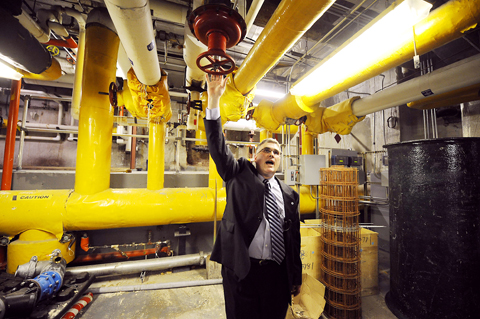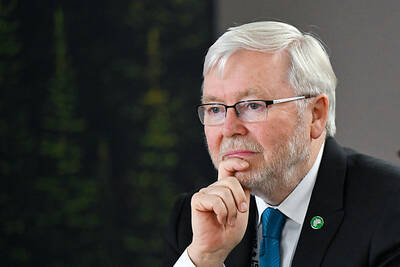Changing windows in New York sounds easy — but changing the planet too? That’s the goal at the Empire State Building, where switching windows, all 6,500, is part of a retrofit meant to transform the tower — the scene of King Kong’s last stand in the Hollywood classic — into an eco-friendly model for the world.
Anthony Malkin, representing the owners, said the multimillion-dollar project — a massive upgrade of heating, cooling and lighting systems — will reduce energy consumption by 38 percent.
Commercial buildings produce 78 percent of greenhouse emissions in New York, so greening the Empire State Building is a big step.

PHOTO: AFP
And the idea is that if you can do that in a 1931 Art Deco skyscraper, you can do it anywhere.
“It has a real rippling effect beyond this building and this city,” said Kathy Baczko at the Clinton Climate Initiative, part of former US president Bill Clinton’s foundation, which is backing the project. “It’s a new beacon for how you can be energy efficient.”
The retrofit adds US$20 million to the US$500 million cost of a general refurbishment underway at the iconic tower.
According to planners, full efficiency gains will kick in by 2013, bringing annual savings of US$4.4 million and placing the skyscraper in the top 10 percent of office buildings for greenness.
Malkin, president of Wien and Malkin, which oversees the building for the owners, including the Malkin family, likes stressing business friendly aspects, including the potential to attract higher-paying tenants.
TREE HUGGER
He talked passionately about preventing global warming from turning the world to “toast,” but bristled during an interview at being seen as a tree hugger.
“It’s not about greening,” said Malkin, 46, whose office carpet, shirt and even tie all happened to be various shades of green. “This is sound business. That’s what this is about.”
What makes the project new, organizers say, is a holistic approach that seeks causes of problems — for example variation in office temperature — as well as solutions.
“People have looked at specific technologies, the lighting, or the heating, but not at the building as a whole,” said Paul Rode, a project executive with the engineering company Johnson Controls.
This analysis took 18 months, in which 65 areas were modeled and eight were chosen as targets for the retrofit, ranging from better insulated windows to occupancy sensors for lights.
The Empire State Building is most famous for being tall, a soaring, tapering stack of 102 floors ending with a multi-colored, illuminated spire.
But Rode says the remake starts underground in the cavernous and wasteful chiller plant, which he describes as “a time warp.”
“Everything you see,” he said, pointing to a wall covered with archaic-looking control dials and red lamps, “is going into that” — a single desktop, flat-screen computer.
That software, as well as hardware like new motors and compressors, will bring sophistication to a system currently churning out heat and cold with little regard to actual demand.
INNOVATION
Up on the 62nd floor, looking down on the toy-like Manhattan and Hudson River, Rode explained how new windows will complement that newly intelligent system.
“The first thing we noticed was that 6,500 windows provided a lot of light, but also heat,” he said.
The current windows are double-glazed. Each will be removed and given a third film, with layers of argon/krypton gas and microscopic aluminum to provide insulation and repel ultra-violet sun rays.
“We want to let in the visible light, but not the heat-producing, non-visible rays,” Rode said.
A former nuclear engineer on navy ships, Rode said he was initially unexcited by the idea of working on an office building.
But the tower presents “very novel complexities” that have captured his imagination.
One of them is performing this top-to-bottom rejuvenation without changing the appearance of the historic building — or getting in the way of 10,500 tenants and almost 4 million annual tourists.
“It’s like changing the black-and-white TV into a color TV, but have it look exactly the same — except for the picture — and all while people are still watching,” he said.
GAME OVER
Surveying the Empire State Building from the terrace at his nearby office, Malkin said the elegant skyscraper was “a big lab, a big test bench” for reducing the carbon footprint of older office buildings everywhere.
“Every single thing was done with the understanding that it has to be part of a replicable process,” Malkin said.
And if the world ignores that challenge?
“Then it’s game over,” Malkin said.

NEXT GENERATION: The four plants in the Central Taiwan Science Park, designated Fab 25, would consist of four 1.4-nanometer wafer manufacturing plants, TSMC said Taiwan Semiconductor Manufacturing Co (TSMC, 台積電) plans to begin construction of four new plants later this year, with the aim to officially launch production of 2-nanometer semiconductor wafers by late 2028, Central Taiwan Science Park Bureau director-general Hsu Maw-shin (許茂新) said. Hsu made the announcement at an event on Friday evening celebrating the Central Taiwan Science Park’s 22nd anniversary. The second phase of the park’s expansion would commence with the initial construction of water detention ponds and other structures aimed at soil and water conservation, Hsu said. TSMC has officially leased the land, with the Central Taiwan Science Park having handed over the

AUKUS: The Australian Ambassador to the US said his country is working with the Pentagon and he is confident that submarine issues will be resolved Australian Ambassador to the US Kevin Rudd on Friday said that if Taiwan were to fall to China’s occupation, it would unleash China’s military capacities and capabilities more broadly. He also said his country is working with the Pentagon on the US Department of Defense’s review of the AUKUS submarine project and is confident that all issues raised will be resolved. Rudd, who served as Australian prime minister from 2007 to 2010 and for three months in 2013, made the remarks at the Aspen Security Forum in Colorado and stressed the longstanding US-Australia alliance and his close relationship with the US Undersecretary

‘WORLD WAR III’: Republican Representative Marjorie Taylor Greene said the aid would inflame tensions, but her amendment was rejected 421 votes against six The US House of Representatives on Friday passed the Department of Defense Appropriations Act for fiscal 2026, which includes US$500 million for Taiwan. The bill, which totals US$831.5 billion in discretionary spending, passed in a 221-209 vote. According to the bill, the funds for Taiwan would be administered by the US Defense Security Cooperation Agency and would remain available through Sept. 30, 2027, for the Taiwan Security Cooperation Initiative. The legislation authorizes the US Secretary of Defense, with the agreement of the US Secretary of State, to use the funds to assist Taiwan in procuring defense articles and services, and military training. Republican Representative

TAIWAN IS TAIWAN: US Representative Tom Tiffany said the amendment was not controversial, as ‘Taiwan is not — nor has it ever been — part of Communist China’ The US House of Representatives on Friday passed an amendment banning the US Department of Defense from creating, buying or displaying any map that shows Taiwan as part of the People’s Republic of China (PRC). The “Honest Maps” amendment was approved in a voice vote on Friday as part of the Department of Defense Appropriations Act for the 2026 fiscal year. The amendment prohibits using any funds from the act to create, buy or display maps that show Taiwan, Kinmen, Matsu, Penghu, Wuciou (烏坵), Green Island (綠島) or Orchid Island (Lanyu, 蘭嶼) as part of the PRC. The act includes US$831.5 billion in